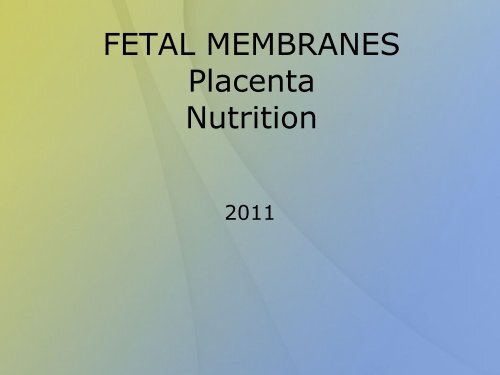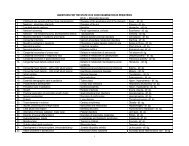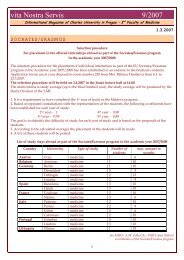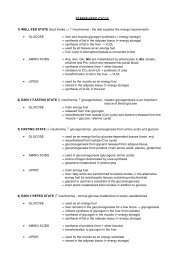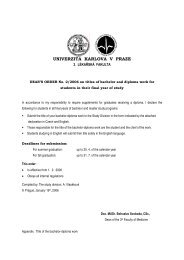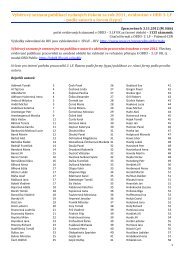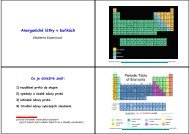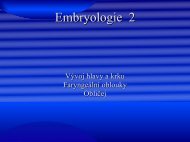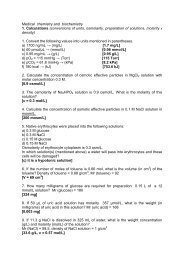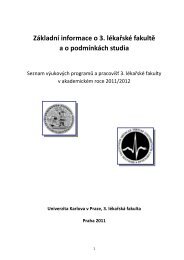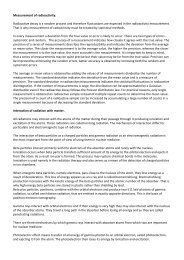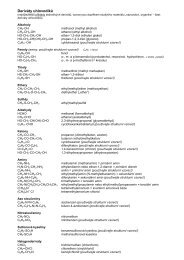FETAL MEMBRANES Placenta Nutrition
FETAL MEMBRANES Placenta Nutrition
FETAL MEMBRANES Placenta Nutrition
Create successful ePaper yourself
Turn your PDF publications into a flip-book with our unique Google optimized e-Paper software.
<strong>FETAL</strong> <strong>MEMBRANES</strong><br />
<strong>Placenta</strong><br />
<strong>Nutrition</strong><br />
2011
Fetal membranes<br />
<br />
<br />
<br />
<br />
<br />
Chorion<br />
Amnion<br />
Yolk sac<br />
Allantois<br />
They develop from zygote, however they<br />
are not involved in embryo formation<br />
except for small part of yolk sac, that<br />
participate on gut formation
Amnion<br />
<br />
<br />
<br />
<br />
<br />
Amnionic fluid<br />
Amnioblasts,<br />
interstitial fluid form<br />
endometrium<br />
Embryo (before skin<br />
keratinization) –<br />
transudation from<br />
body<br />
Umbilical cord<br />
Respiratory system,<br />
urine<br />
<br />
<br />
10th week – 30ml<br />
20<br />
th<br />
week – 350ml<br />
37<br />
th<br />
week - 700-<br />
1000ml
Function of amniotic fluid<br />
<br />
<br />
<br />
<br />
<br />
<br />
<br />
<br />
It allows symetric growth<br />
Protects from infection<br />
Facilitates normal development of lung<br />
Protects from adhesion<br />
Protects from injury<br />
Keeps stabile temperature<br />
Alows free movement<br />
Takes place in homeostasis (electrolytes)
Failures of amnionic fluid<br />
volume<br />
Oligohydramnion – less than 400ml -<br />
rupture of fetal membranes, renal<br />
agenesis – (Potter syndrome) -<br />
pulmonary hypoplasia, pes equinovarus,<br />
face dysmorfy<br />
<br />
Polyhydramnion – more than 2000 ml –<br />
malformed CNS, esofageal atresia, twins,<br />
idiopatic
Yolk sac<br />
<br />
<br />
<br />
<br />
Transfer and metabolism of nutrients – as<br />
liver<br />
Development of blood cells and vessels<br />
-vitelline vascular system<br />
Participation on formation of primitive<br />
gut<br />
Primordial gamets in endoderm of yolk<br />
sac during 3 rd week
Allantois<br />
<br />
<br />
<br />
Development form hindgut – evagination<br />
into embryonic stalk - only transient<br />
Vessels – umbilical arteries and veins for<br />
placenta supply<br />
Intraembryonic part – urachus, urinary<br />
bladder ( ligamentum umbilicale<br />
medianum)
<strong>Placenta</strong><br />
<br />
<br />
Fetal organ providing nutrition and many<br />
other functions:<br />
Function:<br />
− Metabolism (synthesis, for example glycogen)<br />
− Transport of gases and nutrients<br />
− Excretion of waste products<br />
− Production of hormones (hCG)
Embryo nutrition<br />
<br />
<br />
<br />
<br />
Nutrients supply in yolk sac (AA, lipids)<br />
Histiotrophe – secret from glandular cells<br />
in fallopian tube, uterus, digestion of<br />
endometrium<br />
Haematotrophe – maternal blood<br />
Organ that provide nutrition of embryo in<br />
mammals - chorion/placenta
<strong>Placenta</strong> - structure<br />
<br />
<br />
Fetal part – chorion – chorionic plate and<br />
chorionic villi<br />
Maternal part – endometrium – pars<br />
functionalis – decidua basalis
Decidua<br />
<br />
<br />
Zona functionalis that is changing during<br />
pregnancy<br />
<br />
<br />
<br />
Decidua basalis<br />
Decidua capsularis<br />
Decidua parietalis<br />
Progesteron – cell in stroma (fibroblasts)<br />
are changed in decidual cells (content of<br />
glycogen and lipids)+ changes in vascular<br />
supply = decidual reaction
Implantation
Implantation<br />
<br />
<br />
<br />
During implantation embryo invades in<br />
zona functionalis of endometrium<br />
Trophoblast diferentiates into<br />
syncytiotrophoblast and cytotrophoblast<br />
Extraembryonic mesoderm adds to<br />
cytotrophoblast<br />
<br />
= CHORION
Development of chorionic villi<br />
<br />
<br />
<br />
<br />
Primary: Syncytiotrophoblast and<br />
cytotrophoblast<br />
Secondary: Syncytiotrophoblast,<br />
cytotrophoblast and extraembryonic<br />
mesoderm<br />
Tertiary: Vessels occur in mesoderm<br />
Terctiary villi are all from 3<br />
rd<br />
week of<br />
development
<strong>Placenta</strong> development<br />
<br />
<br />
<br />
Chorion laeve<br />
Chorion frondosum<br />
Decidua capsularis get thiner, later<br />
disappears, chorion laeve is on the<br />
surface, it unites with decidua parietalis<br />
and obliterates uterine cavity ( week 22<br />
-24)
Intervillous space<br />
<br />
<br />
It develops from lacunae in sytiotrophoblast<br />
It is divided by placental septa<br />
<br />
Maternal blood – spiral arteries in decidua basalis –<br />
uteroplacental vessels<br />
<br />
<br />
It wash up villi – it is drained into placental veins. Fetal<br />
and maternal blood do not mix !!!<br />
Hemocytoblasts (stem cells) may cross from embryonic<br />
to maternal blood and stay there for relatively long time<br />
(several years) -chimera
<strong>Placenta</strong>l circulation<br />
<br />
<br />
<br />
Umbilical arteries<br />
-deoxygenated<br />
blood from<br />
embryonic body<br />
Chorionic arteries<br />
branching in<br />
chorionic plate<br />
Capillary network<br />
in chorionic villi
<strong>Placenta</strong>l membrana<br />
<br />
<br />
Interface between maternal and fetal<br />
blood<br />
• Syncytiotrophoblast<br />
• Cytotrophoblast<br />
• Connective tissue<br />
• Endothelium of fetal capillary<br />
After week 12 cytotrophoblast gradually<br />
disappears, vessels come near to surface<br />
and get in contact with<br />
syncytiotrophoblast
3rd trimester<br />
<br />
<br />
Nuclei of<br />
syncytiotrophoblast<br />
form aggregations –<br />
syncytial knots that<br />
may set free<br />
Formation of<br />
fibrinoid – it reduces<br />
placental transfer
Syncytiotrophoblast<br />
– microvilli, SER,<br />
RER, GC, mito –<br />
active synthesis<br />
Cytotrophoblast –<br />
undifferentiated<br />
cells – mitoses<br />
<br />
<br />
Basal membrane<br />
Continuous<br />
endothelium
Feto-maternal junction<br />
<br />
Different genotype – necessity to supress<br />
imunity:<br />
<br />
Maternal and fetal tissue are separted by the<br />
cells that do not have typical superficial<br />
antigens. Hormonal changes (progesteron,<br />
glucocorticods)<br />
– Blood - Syncytiotrophoblast<br />
– Connective tissue – Cytotrophoblastic shell<br />
<br />
Stem - anchoring villi attach chorion to the<br />
decidua basalis – inside cytotrophoblastic<br />
plug
<strong>Placenta</strong><br />
<strong>Placenta</strong>l shape – discoid (olliformis) +<br />
<br />
<br />
<br />
haemochorial<br />
<strong>Placenta</strong>l septa – rests of decidua basalis.<br />
They separate placenta from maternal<br />
side in lobes - cotyledons<br />
Cotyledons – contain 2 and more<br />
anchoring villi<br />
Diameter – 15 -20 cm, thickness 2-3 cm,<br />
weight 500 to 600 g
<strong>Placenta</strong>l transfer<br />
<br />
<br />
<br />
<br />
<br />
Difusion<br />
Facilitated difusion<br />
Active transport<br />
Pinocytosis<br />
Other types of transfer:<br />
<br />
<br />
<br />
Damage of placetal barrier – blood cellas<br />
Own activity – Treponema pallidum<br />
Damage due to infection - toxoplasmosa
Transfer<br />
<br />
<br />
<br />
<br />
Many substances from maternal blood<br />
may transfer placental barrier including<br />
drugs<br />
Nutrients – glucose, AK, fatty acids,<br />
water, vitamines, electrolytes<br />
Hormones – only steroid unconjugates<br />
Maternal antibodies, transferin+ iron
Syntesis<br />
<br />
<br />
<br />
<br />
<br />
hCG – human chorionic gonadotropin<br />
hCS – human chorionic somatomammotropin/placental<br />
lactogen<br />
hCT human chorionic thyrotropin<br />
hCACTH human chorionic corticotropin<br />
Progesteron and estrogens
<strong>Placenta</strong>l abnormalities<br />
<br />
<br />
<br />
<br />
<br />
<br />
<br />
Atypical implatation:<br />
<strong>Placenta</strong> previa<br />
<strong>Placenta</strong> accreta<br />
<strong>Placenta</strong> percreta<br />
<strong>Placenta</strong> membranacea<br />
<strong>Placenta</strong> accessoria<br />
Atypical attachment of umbilical cord--<br />
marginal, velamentous
Development of mbilical cord<br />
<br />
<br />
<br />
<br />
Connective stalk with umbilical arteries<br />
and veins and allantois<br />
Ductus omphaloentericus connecting gut<br />
with yolk sac<br />
Extraembryonic coelom<br />
Umbilicus
Development<br />
of umbilical<br />
cord<br />
• Length 50 cm


